2021 MERCEDES-BENZ GLB SUV wheel
[x] Cancel search: wheelPage 299 of 446
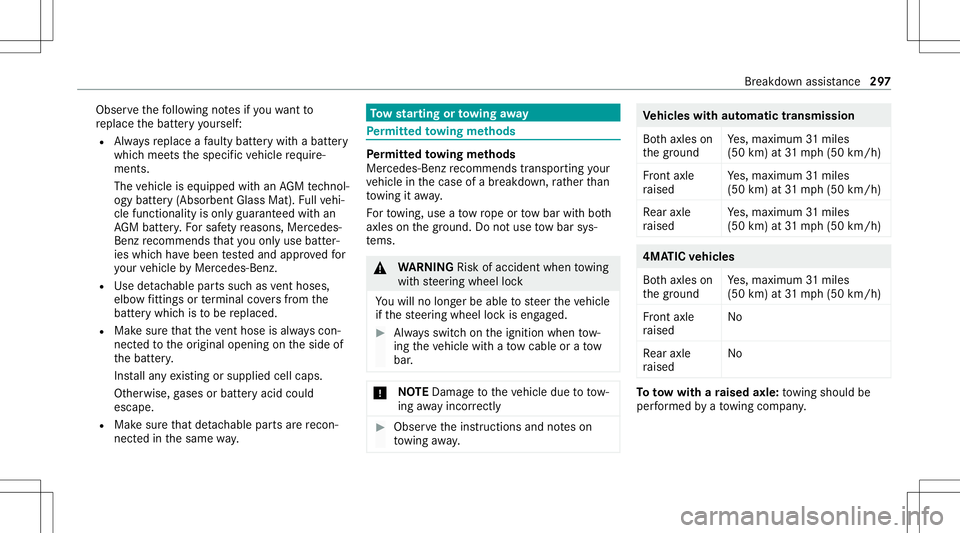
Obser
vethefo llo wing notesif yo uwa ntto
re place thebatt eryyo urself :
R Alw aysre place afa ulty battery wit habatt ery
whic hmee tsthespecif icvehicle requ ire‐
men ts.
The vehicle iseq uipped withan AGMtech nol ‐
ogy batter y(A bso rbentGlas sMa t).Fullve hi‐
cle funct ionality isonl yguar anteed withan
AG Mbatt ery. Fo rsaf etyre ason s,Mer cedes-
Ben zre comme ndsthat youon lyuse batter‐
ies whichhave been tested and appr ovedfo r
yo ur vehicle byMer cedes-Ben z.
R Use detach able partssuc has vent hos es,
el bo wfitting sor term inal covers from the
batt erywhic his to be replaced.
R Mak esur eth at theve nt hos eis alwa ys con‐
nect edtotheor iginal opening ontheside of
th ebatt ery.
Ins tallan yex istin gor supplied cellcaps.
Ot her wise, gases orbatt eryacid could
escape.
R Mak esur eth at detach able partsarere con‐
nect edinthesame way. To
w star ting ortowing away Pe
rm itted towing methods Pe
rm itted towing methods
Mer cede s-Ben zre comme ndstransp orting your
ve hicle inthecase ofabr eakdo wn,rath er than
to wing itaw ay.
Fo rto wing, useato w rope ortow bar withbo th
axle son thegr ound. Donotuse tow bar sys‐
te ms. &
WARNIN GRisk ofacci dent whento wing
wit hsteer ing wheel lock
Yo uwill nolongerbe ableto steer theve hicle
if th esteer ing wheel lockis eng aged. #
Alw aysswitc hon theignition whentow‐
ing theve hicle withato w cable orato w
bar . *
NO
TEDama getotheve hicle duetotow‐
ing away inc orrectl y #
Obs erve theins truction sand noteson
to wing away. Ve
hicl eswith automatic transmiss ion
Bo th axle son
th egr ound Ye
s,maximum 31mile s
(50 km) at31 mp h(5 0km/h)
Fr ont axle
ra ised Ye
s,maximum 31mile s
(50 km) at31 mp h(5 0km/h)
Re ar axle
ra ised Ye
s,maximum 31mile s
(50 km) at31 mp h(5 0km/h) 4MA
TICvehicl es
Bo th axle son
th egr ound Ye
s,maximum 31mile s
(50 km) at31 mp h(5 0km/h)
Fr ont axle
ra ised No
Re ar axle
ra ised No To
tow wit hara ised axle: towing should be
per form ed byato wing company. Br
ea kdo wnassista nce 29
7
Page 301 of 446
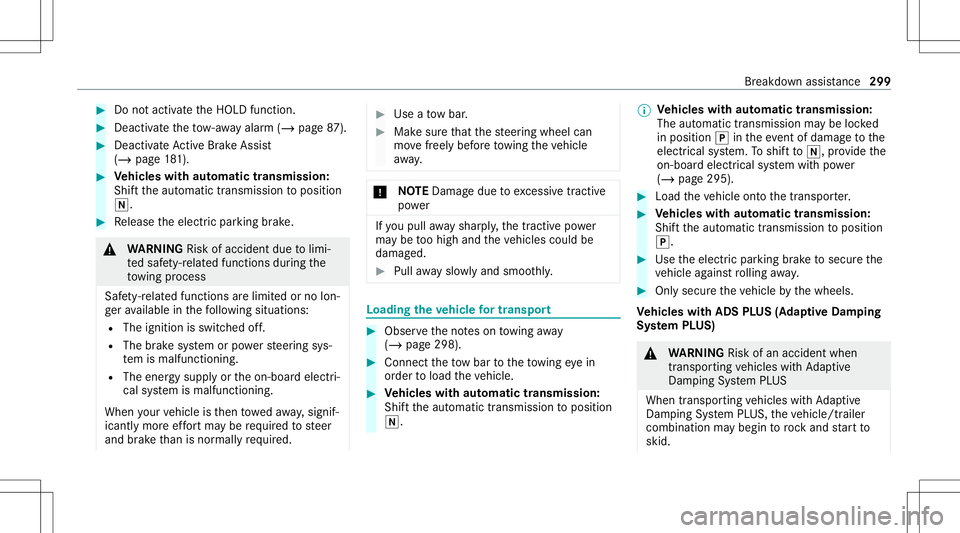
#
Donotacti vate theHOLD function. #
Deact ivat eth eto w- aw ay alar m(/ page87 ). #
Deac tivateAc tiveBr ak eAssi st
( / pag e18 1). #
Vehicl eswith automatic transmiss ion:
Shif tth eaut omatic transmiss iontoposition
005C. #
Release theelectr icpar king brak e. &
WARNIN GRisk ofacci dent dueto limi‐
te dsaf ety-re lat ed func tionsdur ing the
to wing proce ss
Saf ety-re lat ed func tionsar elimit edorno lon‐
ge rav ailable inthefo llo wing situat ions:
R The ignit ionisswitc hedoff.
R The brak esy stem orpowe rst eer ing sys‐
te m ismalfu nctioning.
R The ener gysupp lyor theon- boar delectr i‐
cal system ismalfunct ioning.
When your vehicle isthen towe daw ay,signif ‐
icant lymor eef fort ma ybe requ ired tosteer
and brak eth an isno rm allyre qu ired. #
Use ato w bar . #
Mak esur eth at thesteer ing wheel can
mo vefreely beforeto wing theve hicle
aw ay. *
NO
TEDama gedue toexcess ive tracti ve
po we r If
yo upull away shar ply, thetractiv epo we r
ma ybe toohigh andtheve hicles couldbe
damag ed. #
Pull away slo wlyand smoo thly. Lo
adi ng the vehicl efo rtr ans port #
Obser vetheno teson towing away
( / pag e298). #
Connec tth eto w bar totheto wing eyein
or der toload theve hicle. #
Vehicl eswith automatic transmiss ion:
Shif tth eaut omatic transmiss iontoposition
005C. %
Ve
hicl eswith automatic transmiss ion:
The automatic transmiss ionmaybe locked
in posit ion005Dintheeve ntofdama getothe
electr icalsystem. Toshif tto 005C ,pr ov ide the
on-boar delectr icalsystem withpo we r
( / pag e295). #
Load theve hicle ontoth etra nspor ter. #
Vehicl eswith automatic transmiss ion:
Shif tth eaut omatic transmiss iontoposition
005D. #
Use theelectr icpar king brak eto secur eth e
ve hicle agains tro lling away. #
Onlysecur eth eve hicle bythewheels.
Ve hicl eswith ADSPL US (Adap tiveDam ping
Sy stem PLUS) &
WARNIN GRisk ofan acci dent when
tr ansp orting vehicles withAd aptive
Dam pingSy stem PLUS
When transpor tingvehicles withAd aptive
Dam pingSy stem PLUS, theve hicle/tr ailer
combination maybegin torock and star tto
skid. Br
eakdo wnassis tance 29
9
Page 302 of 446
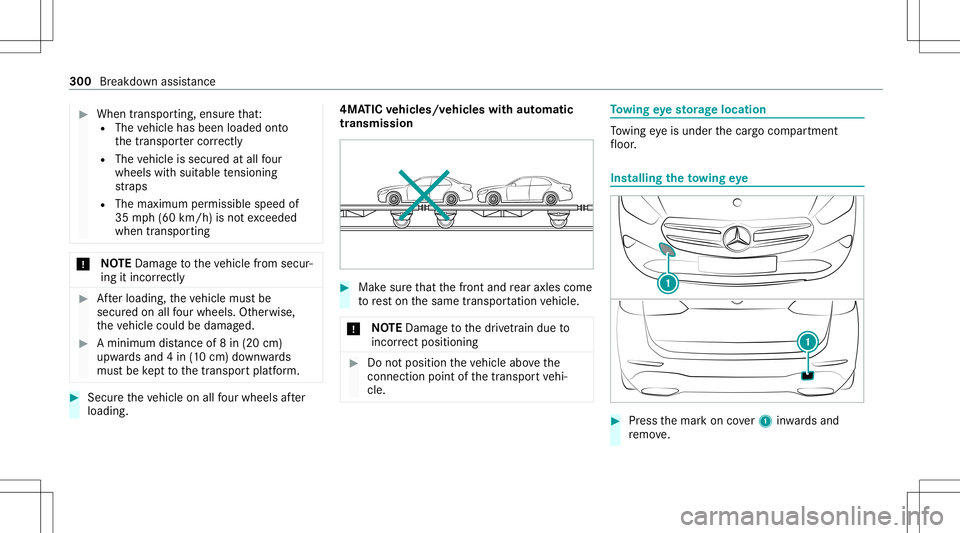
#
When transpor ting,ensur eth at:
R The vehicle hasbeen loaded onto
th etranspor tercor rectl y
R The vehicle issecur edatall four
wheel swit hsuit able tensi oni ng
st ra ps
R The maximum permissible speedof
35 mph(6 0km/h) isno texc eeded
when transpor ting *
NO
TEDama getotheve hicle from secur‐
ing itincor rectl y #
Afterloa ding, theve hicle mustbe
secur edon allfour wheel s.Ot her wise,
th eve hicle could bedamag ed. #
Aminimum distance of8in (20 cm)
up wa rdsand 4in (10 cm) down wards
mus tbe kept tothetranspor tplatf orm. #
Secur eth eve hicle onallfour wheel saf te r
loading . 4MA
TICvehicl es/vehicl eswith automatic
tr ansmiss ion #
Mak esur eth at thefront and rear axle scom e
to rest on thesame transpor tatio nve hicle.
* NO
TEDama getothedr ivet ra in due to
inc orrect pos itioning #
Donotpos ition theve hicle abovethe
connecti onpointofthetranspor tve hi‐
cle. To
wing eyesto rage location To
wing eyeis under thecar gocom partmen t
fl oor . Ins
talling theto wing eye #
Press themar kon cover1 inwa rdsand
re mo ve. 300
Breakdo wnassis tance
Page 307 of 446
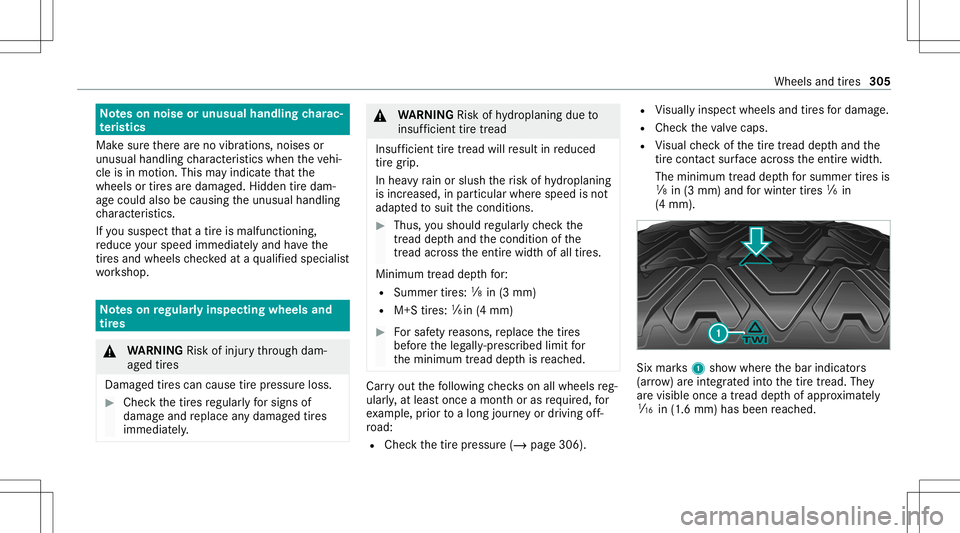
No
teson noise orunusua lhand lingcharac‐
te rist ics
Mak esur eth er ear eno vibr ations, noisesor
unusual handling charact eristic swhen theve hi‐
cle isin mo tion. Thismayindicat eth at the
wheels ortires aredamag ed.Hidde ntir edam‐
ag ecould alsobecausin gth eunusual handling
ch aract eristic s.
If yo ususp ectthat atir eis malf unctionin g,
re duce your spee dimm ediat elyand have the
tir es and wheelsch eckedat aqu alif ied spec ialist
wo rkshop. No
teson regular lyinspect ingwheels and
tir es &
WARNIN GRisk ofinju rythro ugh dam‐
ag ed tires
Dam aged tires can caus etir epr ess ureloss . #
Chec kth etir es regular lyforsigns of
dama geand replace anydamag edtires
immediat ely. &
WARNIN GRisk ofhydroplaning dueto
insuf ficie nttiretrea d
Insu fficien ttir etread willresult inreduced
tir egr ip.
In hea vyrain or slush therisk ofhydroplaning
is incr eased, inpar ticular wherespeed isno t
adap tedto suit thecon ditions . #
Thus, yousho uld regular lych eckth e
tr ea dde pthand thecon dition ofthe
tr ea dacr oss theent ire widt hof all tires.
Minimum tread depthfor:
R Summ ertires: 00CEin(3 mm)
R M+S tires: 00CFin (4mm) #
Forsaf etyre ason s,replace thetir es
bef oreth eleg ally -prescr ibed limit for
th eminimum tread depthisreac hed. Car
ryout thefo llo wing checks on allwheels reg‐
ular ly,at leas tonce amont hor as requ ired, for
ex am ple, prior toalon gjo ur ne yor drivin gof f-
ro ad:
R Chec kth etir epr essur e(/ page306). R
Visual lyinspect wheelsandtires fordama ge.
R Chec kth eva lve caps.
R Visual checkof thetir etread depthand the
tir econt actsurface across theent ire widt h.
The minimum tread depthforsummer tires is
00CE in(3 mm) andforwint ertires 00CF in
(4 mm). Six
mar ks1 showwher eth ebar indicat ors
(ar row )ar eint egr ated intoth etir etread. They
ar evisible onceatread depthofappr oximat ely
00CD in(1.6 mm) hasbeen reac hed. Whee
lsand tires 305
Page 308 of 446
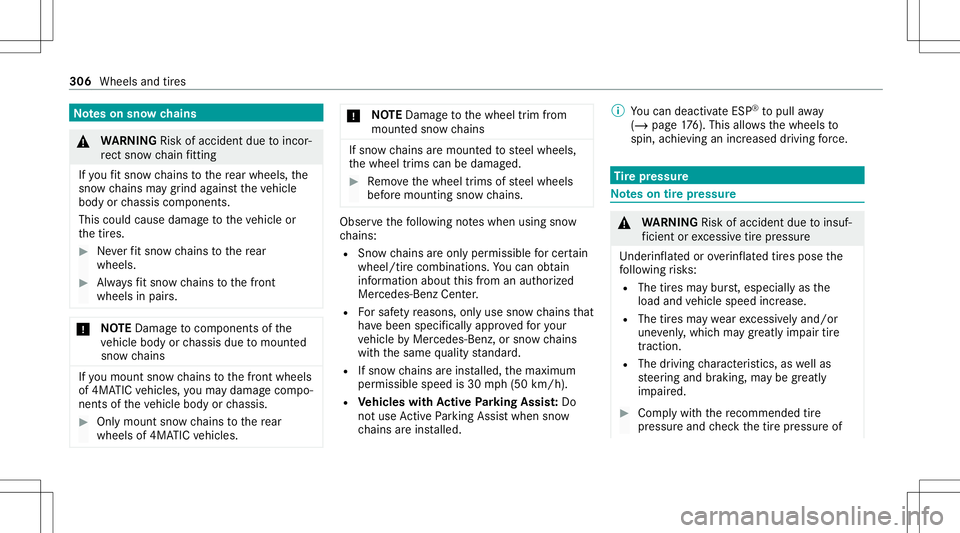
No
teson sno wch ains &
WARNIN GRisk ofacci dent dueto inc or‐
re ct sno wch ain fitting
If yo ufit sno wch ains tothere ar wheels ,th e
sno wch ains maygr ind agains tth eve hicle
body orchassis components.
This couldcaus edamag eto theve hicle or
th etir es. #
Neverfit sno wch ains tothere ar
wheels . #
Alw aysfit sno wch ains tothefront
wheels inpair s. *
NO
TEDama getocom pone ntsofthe
ve hicle body orchassis duetomount ed
sno wch ains If
yo umoun tsn ow chains tothefront wheels
of 4MA TICvehicles, youma ydamag eco mp o‐
nent sof theve hicle body orchassis . #
Onlymount snowch ains tothere ar
wheels of4MA TICvehicles. *
NO
TEDama getothewheel trim from
mount edsno wch ains If
sn ow chains aremoun tedto steel wheels,
th ewheel trims can bedamag ed. #
Remo vethewheel trims ofsteel wheels
bef oremount ingsnowch ains . Obse
rveth efo llo wing noteswhen usingsnow
ch ains :
R Snow chains areon lype rm issible forcer tain
wheel/t ire com binat ions.Yo ucan obtain
inf ormat ionabout this from anaut hor ized
Mer cedes -Benz Cent er.
R Forsaf etyre ason s,on lyuse snow chains that
ha ve been specif icallyapproved foryo ur
ve hicle byMer cedes-Ben z,or sno wch ains
wit hth esame qualit yst andar d.
R Ifsn ow chains areins talled, themaximum
per missible speedis30 mph(50 km/h).
R Vehicl eswith Activ ePa rking Assis t:Do
no tuse ActivePa rking Assistwhen snow
ch ains areins talled. %
Youcan deac tivateES P®
to pull away
( / pag e17 6).Thi sal lo ws thewheels to
spin, achie ving anincr eased driving forc e. Ti
re pres sur e No
teson tirepr essur e &
WARNIN GRisk ofacci dent dueto insuf ‐
fi cie ntor excess ive tir epr ess ure
Under inflate dor ove rinf late dtir es pose the
fo llo wing risk s:
R The tires ma ybur st,especiall yas the
load andvehicle speed increase.
R The tires ma ywe arexc essiv elyand/or
une venly, whic hma ygr ea tly impair tire
traction .
R The drivin gch aract eristic s,as wellas
st eer ing and braking, maybe greatl y
im pair ed. #
Com plywithth ere comme ndedtire
pr ess ureand checkth etir epr essur eof 306
Wheels andtires
Page 309 of 446
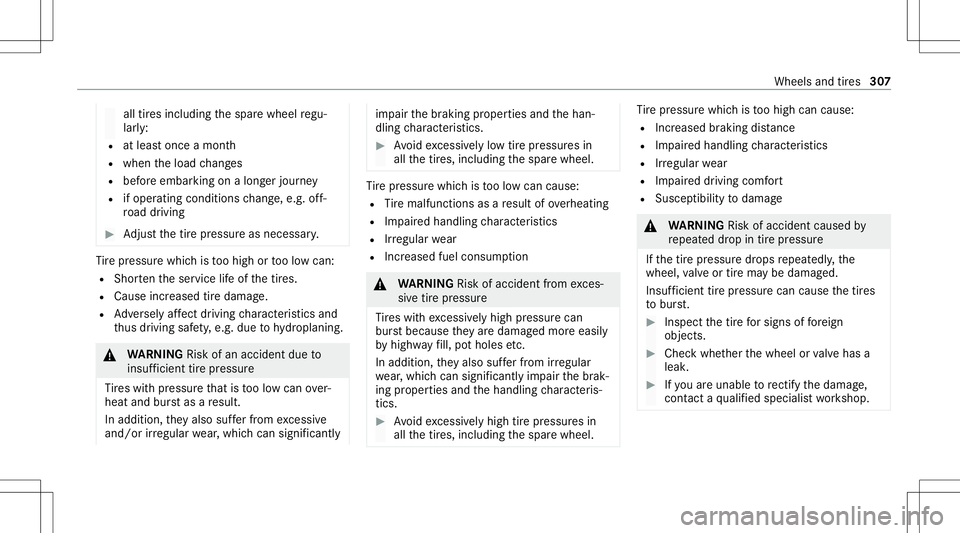
all
tires inc ludin gth espar ewheel regu‐
lar ly:
R atleas tonce amont h
R when theload chang es
R beforeembar kingon alon gerjour ney
R ifoper ating conditions chang e,e.g .of f-
ro ad drivin g #
Adjus tth etir epr essur eas neces sary. Ti
re pressur ewhic his toohigh ortoolow can:
R Shor tenth eser vice life of thetir es.
R Cause increased tiredamag e.
R Adversely affect drivi ng charact eristic sand
th us drivin gsaf ety, e.g. due tohydroplaning. &
WARNIN GRisk ofan acci dent dueto
insuf ficie nttirepr ess ure
Ti re swit hpr essur eth at istoolow can over‐
heat andburstas are sult.
In addition, they also sufferfr om excessiv e
and/or irre gular wear,whic hcan significan tly im
pair thebr aking proper tiesand thehan‐
dling charact eristic s. #
Avoid excessiv elylow tirepr essur esin
all thetir es, including thespar ewheel. Ti
re pressur ewhic his toolow can cause:
R Tire malfu nctions asare sult ofove rheating
R Impair edhandling charact eristic s
R Irre gular wear
R Incr eased fuelconsum ption &
WARNIN GRisk ofacci dent from exces‐
siv etir epr ess ure
Ti re swit hexc essiv elyhigh pressur ecan
bur stbecause they aredamag edmor eeasil y
by highw ayfill, po tholes etc.
In addition, they also sufferfr om irre gular
we ar,whic hcan significan tly im pair thebr ak‐
ing proper tiesand thehandling charact eris‐
tic s. #
Avoid excessiv elyhigh tirepr essur esin
all thetir es, including thespar ewheel. Ti
re pressur ewhic his toohigh cancause:
R Increased brakin gdis tance
R Impaired handl ing charact eristic s
R Irre gular wear
R Impair eddrivin gcom fort
R Sus ceptibility to damag e &
WARNIN GRisk ofacci dent caused by
re peat eddrop intirepr essur e
If th etir epr essur edr ops repeat edly,th e
wheel, valve or tirema ybe damag ed.
Insuf ficie nttirepr ess urecan causethetir es
to bur st. #
Inspect thetir efo rsigns offore ign
obje cts. #
Chec kwhe ther thewheel orvalve has a
leak . #
Ifyo uar eunab leto rectify thedamag e,
con tact aqu alif ied spec ialistwo rkshop. Wheels
andtires 30
7
Page 310 of 446
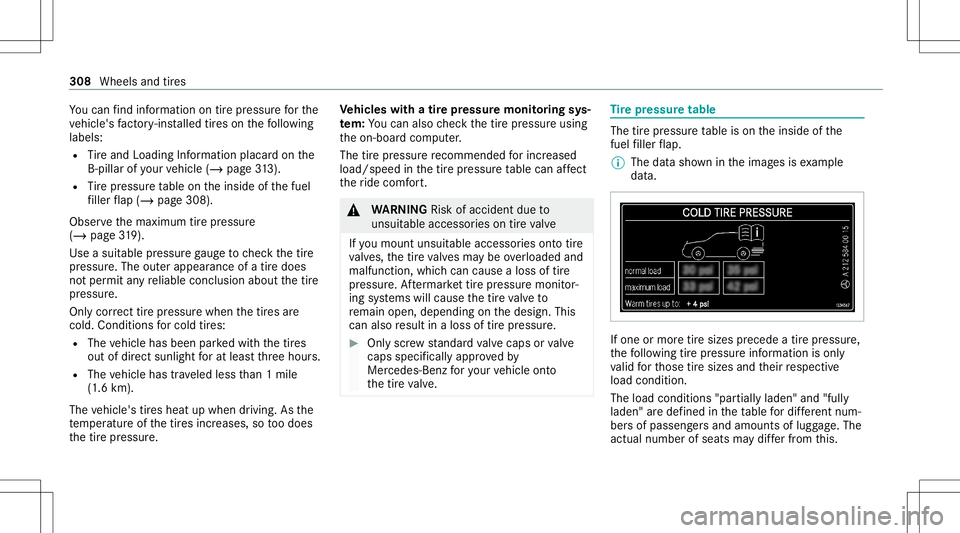
Yo
ucan find informa tionon tirepr ess urefo rth e
ve hicle's fact or y-ins talled tires on thefo llo wing
labels:
R Tire and Loadi ngInfo rm atio nplacar don the
B‑pil larof your vehicle (/page31 3).
R Tire pressur eta ble ontheinside ofthefuel
fi ller flap (/ page30 8).
Obse rveth emaximum tirepr essur e
(/ page31 9).
Use asui table pressur ega ug eto checkth etir e
pr essur e.The outerappear anceofatir edoes
no tper mit anyre liable conclusion aboutthetir e
pr essur e.
Onl ycor rect tirepr ess ure whe nth etir es are
cold. Condition sfo rcold tires:
R The vehicle hasbeen parkedwit hth etir es
out ofdir ect sunlight forat lea stthre ehour s.
R The vehicle hastrave led less than 1mile
(1 .6 km ).
The vehicle's tires heat upwhen driving. Asthe
te mp eratur eof thetir es incr eases, sotoodoes
th etir epr essur e. Ve
hicl eswith atir epr ess uremonit oring sys‐
te m: Youcan also checkth etir epr essur eusing
th eon- board computer.
The tirepr essur ere comme ndedforincr ease d
loa d/spee din thetir epr essur eta ble can affect
th eride comf ort. &
WARNIN GRisk ofacci dent dueto
uns uitable accessories ontireva lve
If yo umoun tuns uitable accessories onto tire
va lves, thetir eva lves ma ybe overloaded and
malfunct ion,whic hcan cause aloss oftire
pr essur e.Afterm arke ttir epressu remonit or‐
ing systems willcause thetir eva lve to
re main open, depending onthedesign. This
can also result inaloss oftirepr essur e. #
Onlyscr ew standar dva lve caps orvalve
cap sspe cifica llyapprove dby
Mer cedes-Ben zfo ryo ur vehicle onto
th etir eva lve. Ti
re pres sur etab le The
tirepr ess ureta ble ison theinside ofthe
fuel filler flap.
% The datasho wnintheimag esisexam ple
dat a. If
on eor mor etir esiz es prece deatir epr essur e,
th efo llo wing tirepr essur einf ormatio nis onl y
va lid forth ose tiresizes andtheir respectiv e
load condition.
The load conditions "partially laden" and"fully
laden" aredef ined intheta ble fordif fere nt num ‐
be rs of passeng ersand amounts oflugg age. The
actual number ofseats maydif ferfr om this. 308
Wheels andtires
Page 312 of 446

pr
essur ete lltale when oneormor eof your
tir es issign ifican tly und er-in flat ed. Accor d‐
ing ly,whe nth elow tirepr essur ete lltale illu‐
min ates, yousho uld stop and checkyo ur
tir es assoo nas poss ible, andinflateth em to
th epr oper pressur e.Driving onasignif i‐
cant lyunder -inflated tirecauses thetir eto
ove rheat and canlead totirefa ilur e.Un der -
inf lation alsoreduces fuelefficie ncy and tire
tr ea dlife ,and mayaf fect theve hicle's han‐
dling andstopping ability.Please note that
th eTPMS isno ta subs titutefo rpr oper tire
maint enance, anditis thedr iver's responsi‐
bility tomaint aincorrect tirepr ess ure, eve n
if under -inflatio nhas notre ac hed theleve lto
tr ig ge rill umina tionoftheTPMS low tirepr es‐
sur ete lltale.
Yo ur vehicle hasalso been equipped witha
TPMS malfunction indicatortoindic ateth at
th esy stem isno toper ating proper ly.The
TPMS malfunct ionindicat oriscombin edwith
th elow tirepr essur ete lltale. When thesy s‐
te m detects amal functi on,theindicat or
lam pwill flash forapp roxima tely one minu te and
then remain continuously illumina ted.
This sequence willcontinue upon subseq uent
ve hicle star t-ups aslon gas themalfunct ion
ex ists.
When themalfunct ionindicat orisillumina‐
te d, thesy stem mayno tbe able todetect or
sig nal low tirepr ess ureas intende d.TPM S
mal functi onsmayoccu rfo ra va riet yof rea‐
son s,inc ludin gth eins tallation ofreplace‐
ment oralternat etir es orwheels ontheve hi‐
cle that prev ent theTPMS from func tioning
pr oper ly.
Alw aysch eckth eTPMS malfunct iontelltale
af te rre placing oneormor etir es orwheels
on your vehicle toensur eth at there place‐
ment oralternat etir es and wheels allowthe
TPMS tocontinu eto function proper ly. The
system checks thetir epr essur eand thetir e
te mp eratur eof thetir es installed totheve hicle
by means ofatir epr essu resensor .
The tirepr essur eand thetir ete mp eratur e
appear inthemultifunc tiondispla y
(/ page31 1). If
th er eis asubs tantia lpr ess ureloss orifth e
tir ete mp eratur eis exc essiv e,youwill bewarned
in thefo llo wing ways:
R viadisp lay messa ges(/ page39 1)
R viathe0077 warning lam pin theins trument
clus ter(/ page41 0)
The tirepr essu remonit oring system isonl yan
aid. Itis thedr iver's responsibili tyto setth etir e
pr essur eto there comme ndedcoldtirepr ess ure
su itab leforth eoper ating situation .
In mos tcases, thetir epr essur emonit oring sys‐
te m wil lau tomatical lyupdat eth ene wrefere nce
va lues afte ryo uha ve chang edthetir epr essur e.
Yo ucan ,ho we ver,also updat eth ere fere nce val‐
ues byrestar tin gth etir epr essur emonit oring
sy stem manually (/page31 1).
Sy stem limit s
The system maybe impair edorma yno tfunc tion
in thefo llo wing situat ions:
R thetir epr essur ehas been setincor rectly
R ther eis asudden pressur eloss caused, for
ex am ple, byafo re ign obje ctpene trating the
tir e 31
0
Wheels andtires